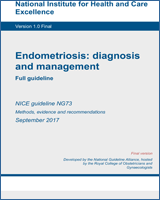| Endometriosis | | | | | |
|---|
| Pain score (reduction in VAS at 12 months) - Overall | - | The mean pain score (reduction in VAS at 12 months) - overall in the intervention groups was
0 higher
(1.22 lower to 1.22 higher) | MD 0 (−1.22 to 1.22) | 103
(1 study) | ⊕⊕⊝⊝
Low1 |
| Pain score (reduction in VAS at 12 months) - Pelvic | - | The mean pain score (reduction in VAS at 12 months) - pelvic in the intervention groups was
0.1 lower
(1.3 lower to 1.1 higher) | MD −0.1 (−1.3 to 1.1) | 103
(1 study) | ⊕⊕⊝⊝
Low1 |
| Pain score (reduction in VAS at 12 months) - Dyspareunia | - | The mean pain score (reduction in VAS at 12 months) - dyspareunia in the intervention groups was
1.3 higher
(0.29 lower to 2.89 higher) | MD 1.3 (−0.29 to 2.89) | 103
(1 study) | ⊕⊝⊝⊝
Very low1,2 |
| Unintended effects (reduction from VAS score by 12 months after operation (nausea, vomiting) - Nausea | - | The mean unintended effects (reduction from VAS score by 12 months after operation (nausea, vomiting) - nausea in the intervention groups was
1.1 higher
(0.14 lower to 2.34 higher) | MD 1.1 (−0.14 to 2.34) | 103
(1 study) | ⊕⊕⊝⊝
Low2,3 |
| Unintended effects (reduction from VAS score by 12 months after operation (nausea, vomiting) - Vomiting | - | The mean unintended effects (reduction from VAS score by 12 months after operation (nausea, vomiting) - vomiting in the intervention groups was
0.2 higher
(0.71 lower to 1.11 higher) | MD 0.2 (−0.71 to 1.11) | 103
(1 study) | ⊕⊕⊕⊝
Moderate3 |
| Unintended effects (reduction from VAS score by 12 months after operation (nausea, vomiting) - Bloating | - | The mean unintended effects (reduction from VAS score by 12 months after operation (nausea, vomiting) - bloating in the intervention groups was
0.9 higher
(0.3 lower to 2.1 higher) | MD 0.9 (−0.3 to 2.1) | 103
(1 study) | ⊕⊕⊝⊝
Low2,3 |
| Endometrioma | | | | | |
|---|
| Recurrence of pelvic pain - Dysmenorrhoea | 548 per 1,000 | 389 fewer per 1,000
(from 247 fewer to 466 fewer) | RR 0.29 (0.15 to 0.55) | 104
(2 studies) | ⊕⊕⊕⊝
Moderate3 |
| Recurrence of pelvic pain - Non-menstrual pelvic pain | 529 per 1,000 | 429 fewer per 1,000
(from 127 fewer to 503 fewer) | RR 0.19 (0.05 to 0.76) | 37
(1 study) | ⊕⊕⊝⊝
Low2,3 |
| Pregnancy rate after surgical treatment | 233 per 1,000 | 242 more per 1,000
(from 56 more to 552 more) | RR 2.04 (1.24 to 3.37) | 138
(3 studies) | ⊕⊕⊕⊝
Moderate2,4 |
| Recurrence of endometrioma - At 12 months | 256 per 1,000 | 146 fewer per 1,000
(from 69 fewer to 192 fewer) | RR 0.43 (0.25 to 0.73) | 258
(4 studies) | ⊕⊕⊕⊕
High |
| Recurrence of endometrioma - At 60 months | 368 per 1,000 | 147 fewer per 1,000
(from 261 fewer to 96 more) | RR 0.6 (0.29 to 1.26) | 74
(1 study) | ⊕⊕⊝⊝
Low5 |
| Reoperation after surgical treatment up to 60 months follow-up | 94 per 1,000 | 59 fewer per 1,000
(from 85 fewer to 33 more) | RR 0.37 (0.1 to 1.35) | 174
(2 studies) | ⊕⊝⊝⊝
Very low4,5 |
